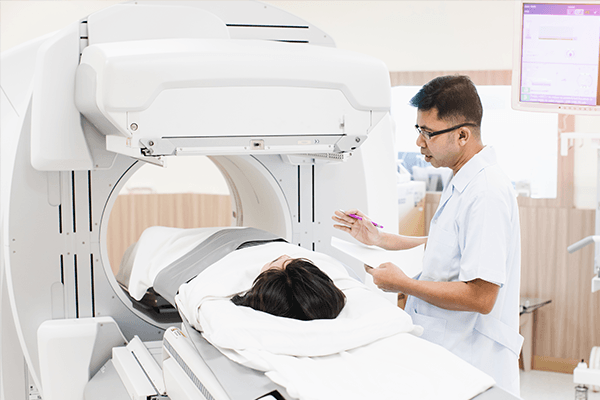How Big Is the Risk of Workers Getting Lung Cancer?

Lung cancer is still a leading cause of death in Indonesia. The main carcinogen that causes it is smoke. As an industrialized country that is still developing, pollution affects the lives of Indonesian employees. How serious is the threat?
Did you know Chrisye? He was a musician who created numerous catchy nostalgic songs. Anak Sekolah, Kemesraan, and Panah Asmara are just a few of his outstanding masterpieces. Unfortunately, the country's proud musician died of lung cancer.
Chrisye was a heavy smoker throughout his life. This is what led to the development of cancer in his lungs. Aside from cigarette smoke, other types of smoke, such as automobile fumes, combustion fumes, manufacturing gases, and food fumes, can cause lung cancer.
Lung cancer

Lung cancer is the leading cause of cancer death in men, according to the WHO. For women, it ranks second only to breast cancer. Scar tissue that forms in the lungs can lead to lung cancer. If you smoke or are exposed to pollutants on a daily basis, your cancer will be more aggressive.
Primary lung cancer is categorized as follows:
1. Non-small-cell lung cancer (NSCLC)
This malignancy is classified into three types: squamous cell carcinoma, adenocarcinoma, and giant cell carcinoma. Common symptoms include a chronic cough, shortness of breath, weight loss, and coughing up blood. This is the most prevalent form (approximately 87% of all cases).
2. Small-cell lung cancer (SCLC)
This cancer is rarer but more aggressive. Spread or metastasize through blood vessels more quickly than NSCLC. Symptoms that may arise include chest pain, chronic cough, difficulty breathing, wheezing, coughing up blood, hoarseness, difficulty swallowing, weight loss, fatigue, and swelling of the face or blood vessels around the neck.
Heavy smokers and people who frequently inhale cigarette smoke and/or pollutants are prone to this type of cancer.
Smoking is the leading cause of lung cancer. Not only does smoking have easier access to the lungs, but it also contains carcinogens that destroy the cells lining the lungs. The more frequently you are exposed to smoke, the more overwhelmed your body is in attempting to repair the harm. Abnormal cell alterations or cancer are unavoidable if allowed untreated.
Lung cancer risk in the workplace

With 2.21 million cases, lung cancer is the world's second most common malignancy, according to the WHO. In 2020, around 1.80 million people died as a result of it. Stress and strain during the COVID-19 pandemic lockdown are suspected of increasing the number of smokers among young adults, which is thought to have contributed to the number of cases.
When we look at the big picture, it's not just about the pandemic. Young folks tend to smoke more aggressively after starting a job. When we consider environmental settings where air quality is degrading, it appears that lung cancer demands more attention.
Work consumes more than half of a person's awake hours. Be grateful if you have control over the air quality at your workplace since individuals who work in an industrial setting do not. Workers here are at risk of being exposed to a variety of smoke, dust, and carcinogens.
According to the International Agency for Research on Cancer (IARC), the following compounds have the potential to cause and worsen lung cancer.
- Asbestos. All varieties include actinolite, amosite, anthophyllite, chrysotile, crocidolite, and tremolite.
- Beryllium and beryllium compounds
- Bis (chloromethyl) ether and chloromethyl methyl ether (technical grade).
- Cadmium and cadmium compounds
- Compounds of chromium (VI).
- Coal pitch.
- Engine exhaust, diesel
- Nickel compounds.
- Outdoor air pollution
- Particulate matter in outdoor air pollution
- Plutonium.
- Radon-222 and its byproducts
- Silica dust and crystals, such as quartz or cristobalite
- Soot.
- Sulfur mustard.
- Tobacco smoke.
- Welding fumes.
- X-ray and gamma radiation
The following occupations have a high risk of lung cancer:
1. Medical workers
Medical workers are particularly vulnerable to lung diseases that can lead to cancer, such as tuberculosis and influenza. Latex exposure to alcohol, such as through gloves, can potentially have a negative impact on lung health.
2. Factory workers
Factory workers may be exposed to a variety of hazards. Burning smoke, metal, and fine sand, for example, can all harm lung health. Silicosis can also be caused by inhaling too much silica.
3. Construction workers
Asbestos is a very dangerous material if inhaled over a long period of time. This material is so prevalent in building construction situations that it endangers the health of personnel nearby. Mesothelioma, a kind of cancer, can be caused by even minor exposure.
4. Firefighter
When faced with thick smoke, it's difficult not to think of firefighters. Firefighters must contend with smoke from burning materials ranging from plastic to wood to metal as part of their job to extinguish fires. As a result, firefighters must be outfitted with self-contained breathing apparatus that must always be used.
5. Miners
Miners work underground, where much of the material has accumulated, including coal dust. As a result, miners are in danger of developing lung disorders such as bronchitis and pneumoconiosis (black lungs).
Screening and prevention
Cancer risk can be reduced in the following ways:
- Do not smoke or be exposed to secondhand smoke.
- Maintain your body weight by consuming nutritious foods and exercising regularly.
- Avoid or limit alcohol consumption.
- Avoid exposure to smoke, dust, and other fine particles by using a mask.
- Comply with job safety procedures to avoid radiation from dangerous materials.
If the aforementioned preventive steps fail, the only way to find out if malignant or precancerous cells are forming in your body is to get screened. If you think you are experiencing the symptoms of lung cancer, seek medical screening right away.
One of the lung screenings is a low-dose computed tomography scan (CT-Scan). Medical personnel will first review your medical records and do an initial checkup (if necessary) before beginning the CT scan procedure. If cancer cells are found and reach a specific stage, a biopsy or surgery may be recommended.
The lungs are a pair of vital organs. They cannot be changed or limited to one course. That’s why we must take care of our lungs' health.



